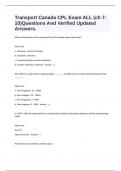Transport Canada CPL Exam ALL (ch 7-
10)Questions And Verified Updated
Answers.
What is the direction of the vortex off the left and right wing respectively?
Select one:
a. Clockwise, counter-clockwise
b. Clockwise, clockwise
c. Counter-clockwise, counter-clockwise
d. Counter-clockwise, clockwise - Answer a
The width of a wing vortex is approximately ________ in width and can trail the generating aircraft by
________.
Select one:
a. Two wingspans, 10 - 16NM
b. One wingspan, 10 - 16NM
c. Two wingspans, 3 - 5NM
d. One wingspan, 3 - 5NM - Answer a
It is ATC's ultimate responsibility to provide wake turbulence separation between arriving and departing
traffic.
Select one:
True (T)
False Correct (F) - Answer f
The idle blast area behind a medium jet is:
,Select one:
a. 200'
b. 450'
c. 600'
d. 1200' - Answer b
Regarding wake turbulence categorization, the term "Heavy" refers to aircrafts with takeoff weights
______ lbs or more
Select one:
a. 300,000
b. 136,000
c. 176,000
d. 324,000 - Answer a
Wake turbulence is caused anytime the aircraft is:
Select one:
a. Creating lift.
b. Clean, slow, and light.
c. At an altitude greater than two wingspans.
d. Accelerating during the take-off roll. - Answer a
Wing tip vortices sink at _______ to _______ f.p.m., and ____________ as they descend.
Select one:
a. 400 - 500, weaken
b. 200 - 300, strengthen
c. 400 - 600, strengthen
d. 500 - 800, weaken - Answer a
,In a non-radar environment, ATC will apply a ______ min separation interval to any aircraft that
commences its take off into the wake of a known _________ aircraft if the aircraft concerned
commences the take off from threshold of the same runway.
Select one:
a. 1.5, Light.
b. 2, Medium.
c. 3.5, Heavy.
d. 2, Heavy.
Check - Answer d
Which of the following is correct regarding ATC radar departure separation minima, when the preceding
IFR/VFR aircraft and an aircraft vectored directly behind it at less than 1000'?
Select one:
a. Heavy behind a heavy: 4mi. C
b. Light behind a medium: 5mi.
c. Light behind a heavy: 4mi.
d. Medium behind a heavy: 6mi. - Answer a
ATC does not apply the separation interval, specified in Question 11, between a _________ and a(an)
__________ aircraft but will issue wake turbulence advisories to _________ aircraft?
Select one:
a. Medium, Heavy. Light.
b. Light, Medium. Medium.
c. Light, Medium, Light.
d. Heavy, Medium, Light. - Answer c
ATC will apply separation intervals of up to _______minutes when the projected flight paths of any
following aircraft will cross that of a preceding ___________ aircraft?
Select one:
, a. Three, Heavy.
b. Two, Medium.
c. Three, Medium.
d. Two, Heavy. - Answer a
Controllers are responsible for ensuring wake turbulence separation for _______ departures?
Select one:
a. VFR.
b. IFR / VFR if the pilot has not waived wake turbulence separation minima.
c. IFR / VFR.
d. IFR. - Answer d
After a crash in a remote area, how would you signal distress?
Select one:
a. By use of flares.
b. Arrange branches to form the letters S O S.
c. Three fires arranged in a triangle.
d. By use of the ELT. - Answer c
The appropriate transponder code for an emergency is:
Select one:
a. Code 1400 if above 14,000 feet, and 1200 otherwise.
b. Code 7700 at any altitude.
c. Code 7600.
d. Either code 7500 or 7700. - Answer b
To whom should you report an overdue aircraft?
Select one:




